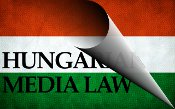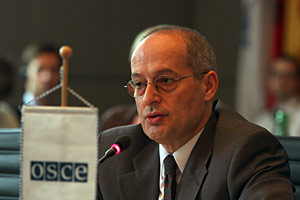 Hungary’s new model of media regulation is creating a chilling effect and undermining freedom of expression says an international partnership mission comprised of leading press freedom and media development organizations.
Hungary’s new model of media regulation is creating a chilling effect and undermining freedom of expression says an international partnership mission comprised of leading press freedom and media development organizations.
The partnership mission to Hungary, which took place from 14th to 16th November, included meetings with lawyers, journalists, editors, professional associations, representatives of civil society, the new media authorities, and the government representative to discuss the situation regarding the enactment and implementation of the new media law, which went into effect on January 1, 2011.
Since then the new law, initiated by the ruling Fidesz party to replace the outdated regulations from 1986, is dealing with international criticism. The new law is broad and uncertain. It faces widespread criticism, especially from European Parliament and OSCE.
If it is successful, media freedom across Europe will be under threat as there will be a new model of media regulation on the continent.
What’s wrong with it?
The new media law created the National Media and Infocommunications Authority which has statutory powers to fine media organisations up to €727,000, oversees regulation of all media including online news websites,  and acts as an extra-judicial investigator, jury and judge on public complaints.
and acts as an extra-judicial investigator, jury and judge on public complaints.
According to Mike Harris, left, the Head of advocacy for Index on Censorship, the new media authority is portrayed as an arm’s length government agency.
Annamaria Szalai, the President of the Media Authority is a known Fidesz supporter and all five members of the Media Council were delegated by exclusively by the Fidesz majority in Parliament. Members of the Media Council serve a nine-year term (over 2 parliamentary cycles) so even in the event of a change of government the media authority will still be dominated by Fidesz delegates.
Co-regulation is neither statutory regulation nor self-regulation. Those bound by the Media Authority include the Hungarian Association of Internet Content Providers, all TV stations and major newspapers.
All volunteered to enter co-regulation which allows the Media Council to rule on received complaints. Yet, there was little choice. For organisations that remain outside the code, the Media Authority can levy fines of up to €727,000 for breaches of the new national media law.
Inside co-regulation, fines cannot be levied, but the grounds for censor journalists are exactly the same as the national media law — and both are broad and uncertain. Hungary has forced the press to internalise a code that is far stricter than in other European countries.
Law outsources media censorship to the owners
One of the strongest provisions is that media owners should be “fit and proper”. In Hungary under Articles 185 – 189 of the new law, media owners who have previously been the subject of complaints upheld by the Media Council cannot bid for further licenses.
Whilst it’s fashionable to suggest such provisions in the UK after phone-hacking, the result in Hungary is chilling. Journalists told the mission that media owners are keen to avoid any possible transgressions of the law and their contracts of employment are being edited to include reference to the new law.
M iklos Haraszti, the Hungarian former OSCE representative on freedom of the media is damning: “It is outsourcing media censorship to the owners.”
iklos Haraszti, the Hungarian former OSCE representative on freedom of the media is damning: “It is outsourcing media censorship to the owners.”
Find Haraszti’s notes on Hungary’s media law package here.
New law seeks to (over)protect the audience
At the heart of the new media law is a requirement to protect the audience from insult, threats to public morality, and hatred whether against a minority, or the majority. Its terms (Article 4, 14, 17) are broad and the grounds for investigation by the Media Authority uncertain.
As Dr Judit Bayer points out, the law “may restrict any critical statement about any person or organisation”. Even defamation of religions is now an actionable offence.
The media code embodies a wide set of protections for the audience. This includes an obligation for broadcasters to warn viewers before the transmission of “any image or sound effects in media services that may hurt a person’s religious, faith-related or other ideological convictions or which are violent or otherwise disturbing” (Article 14 – Requirements regarding the content of media services).
The code applies to any for-profit media, whether within a limited spectrum, in print, or online.
The mission raised with the Media Council’s President the possible imbalance between the positive obligation Hungary has to protect freedom of expression and the breadth of the grounds for complaint under the media code.
Annamaria Szalai was keen to emphasize that ‘not a single forint’ of fines have been levied to date. This is of cold comfort to journalists writing on controversial matters, where a single complaint to the Media Authority could mean the end of their career.
Journalists can be forced to reveal their sources
Harris emphasizes that at the same time, the government’s new media law initiated measures that remove protections for journalistic sources, which the mission found to be incompatible with European law.
The new law allows journalists to be forced to reveal their sources “in order to protect national security and public order or to uncover or prevent criminal acts”.
Whilst there is a public interest clause, as the European Court of Human Rights has found in past cases, the protection of journalistic sources is taken very seriously and the “public order” proviso is highly unlikely to pass this threshold.
 Tamas Bodoky, the founder of investigative website Atlatszo.hu is currently facing the possibility of 5 years in prison for refusing to reveal the source of a leak to his website. He has been questioned by the police who told him he had to reveal his source. He alleges that his home was entered without a warrant. Bodoky is prepared to take his case to Strasbourg – in the meantime, a hard drive storing the contents of his website has been seized by the police.
Tamas Bodoky, the founder of investigative website Atlatszo.hu is currently facing the possibility of 5 years in prison for refusing to reveal the source of a leak to his website. He has been questioned by the police who told him he had to reveal his source. He alleges that his home was entered without a warrant. Bodoky is prepared to take his case to Strasbourg – in the meantime, a hard drive storing the contents of his website has been seized by the police.
Hungary’s new media law allows individuals to take action against journalists and online content for non-criminal offences through co-regulation. With media owners likely to discipline or sack journalists who attract complaints, one can see that co-regulation is likely to deliver the privatisation of state censorship.
International Mission’s findings
The International Partnership Mission of freedom of expression and media development groups consisted of:
Article 19, Freedom House, Index on Censorship, Independent Journalism Centre Moldova, International Press Institute, International Media Support, European Federation of Journalists, Media Diversity Institute, Open Society Media Programme, the Network for Reporting on Eastern Europe, South East Europe Media Organisation and South East European Network for Professionalisation of Media.
Read the findings of the Mission here.
Related articles:





